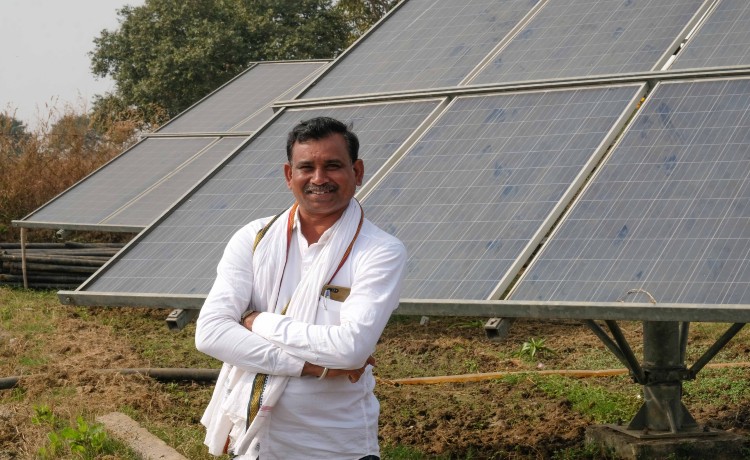Through a recent study conducted on Solar Irrigation Pumps provided by Ambuja Foundation, Nabarun Sen Gupta, a rural development professional, shares insights and key features of the importance of such pumps inspite of the given challenges.
Since 2014-15, Ambuja Foundation, has supported farmers interested in installing Solar Irrigation Pumping devices - converting solar energy into electricity to run the pumping system, replacing erratic grid supply and pollution-causing diesel-powered versions. As a result, 193 pumps catering to 193 farmers irrigating 213 acres of land have been in operation in four locations. These irrigation pumps are non-pollutant and use solar energy to carry out irrigation on agricultural land.
However, Ambuja Foundation has seen a sudden spurt in demand for installing these solar-powered irrigation devices - with more farmers showing interest and making upfront payments for installing the devices. Farmers provided two reasons for their decision to invest in Solar pumping devices. The major reason was the absence of electrical connection at their farms, and continuing with the diesel pumping devices was costly for them. Some farmers came up with the explanation of massive power cuts that makes it extremely difficult to continue farming.

Whilst the installation cost of this infrastructure is on the higher side, serving as a disincentive to farmers willing to invest, Ambuja Foundation is helping farmers tap into a Government Programme to subsidise the initial investments - prompting some farmers to fund the rest. Ambuja Foundation has also come forward with a financial support package to provide more incentives and further subsidize the investment cost. The share of the investments made by the three partners- Government, Farmers and Ambuja Foundation is shown below.

Insights from Farmers Adopting Solar Pump for Irrigation
Farmers have reported a number of benefits from the installation of solar pumps, which provides further incentive for other farmers to follow suit.
1. Expansion of Area under Irrigation - Agricultural intensity has increased from 1.7 to 2.32. All of this has been possible as farmers grow crops almost the entire year round. The growth is about 62%. Besides this, the data shows that solar irrigation supports 58% of the total land under irrigation. The remaining area under irrigation receives irrigation from electricity and diesel pumping devices.
2. Higher Cropping Diversity - Farmers, after installing the Solar systems, have made significant diversification regarding the crops they grow now. Many farmers have moved away from producing a single crop to growing multiple crops during different seasons. It adds to their nutritional diversity and also diversifies their agricultural portfolio. Diversification also helps in reducing livelihood risks.

Table: Crop Diversity (% of Farmers)
|
|
Number of Crops | ||||
|
Season |
1 |
2 |
3 |
4 |
5 |
|
Khariff |
37.9 |
34.5 |
17.2 |
3.4 |
6.9 |
|
Rabi |
34.5 |
48.3 |
17.2 |
0.0 |
0.0 |
|
Summer |
41.4 |
10.3 |
0.0 |
0.0 |
0.0 |
3. Other Benefits
·
Investments in undertaking agricultural operations
have seen a significant reduction.
·
Expansion of area under agriculture operation
during Rabi and Summer Months.
·
Cost savings through the reduced engagement of labor
to undertake irrigation.
·
Increased water productivity
·
Increased yield
·
Good sleep at night.
·
No associated risks of electrocution.
·
User Friendly: Women and Children can also
operate the system with ease.
·
No cost of maintenance except occasional
cleaning of the solar panels.
Whilst these solar pumps are helping farmers access more reliable
power for accessing water, they are not without their limitations. One limitation is the time taken for
installation. Government procedures are often lengthy and hence time-consuming.
For example, farmers mentioned that it took six months to almost a year to
complete the installation.
Additionally, the installed solar systems can irrigate lands
in a limited area, and irrigation is only possible on sunny days. To tackle
this, those farmers with larger parcels of agricultural land had been using
other energy-run pumping devices to supplement their solar pumps. Also, farmers
use different energy sources to irrigate during peak periods. These peak
periods are during Rabi and summer seasons. Almost 2/3rd of the farmers had
diesel / electrical pumping units alongside the solar pumps to irrigate the
land.
Despite this, Solar Pumps are in
increased demand by farmers. Starting in
Chirawa Rajasthan in 2014-15, the programme expanded to three other locations,
namely Bhatapara, Raigadh and Dadri from 2015-16 onwards. Today, the highest
concentration of the solar pumps are at Chirawa (150), followed by Bhatapara
(28), Raigadh (10) and Dadri (5).
Nabarun Sen Gupta is involved in working on rural development issues for almost around two and half decades. He specializes in supporting organizations / agencies involved with various kinds of developmental efforts focusing on livelihoods. He also is a prolific trainer on Gender and poverty perspectives around Rural Livelihoods. He has worked with grassroots agencies and also with corporate social responsibilities and with research and academic institutions. Apart from his exposure to development work in India, he had been associated with establishing a Virtual Livelihood School in East Africa along with partners of Ford Foundation. Nabarun is also involved as National Resource Person (NRP) for rolling out a recently launched programme of the central government on Sustainable agriculture and Livestock. He provides his services to the NRLM and also to a few State Rural Livelihood Missions.



.png)
.png)


0 Comment